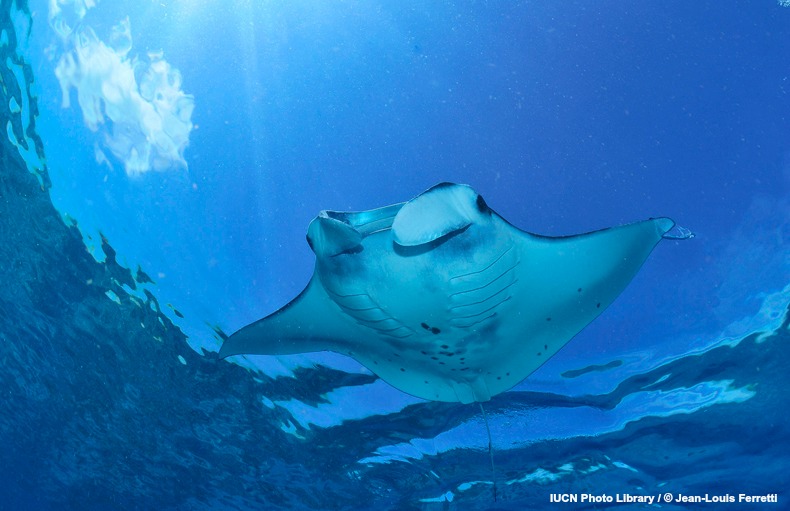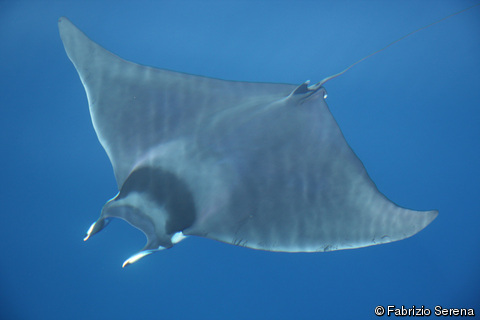Turning the tide for devil rays
Manta rays are graceful, iconic marine animals sought out by scuba divers around the globe. Far less well-recognised are the devil rays, a group of nine species that are closely related to manta rays and are indistinguishable to all except experts. While the popularity and name recognition of manta rays with tourists has led to heightened interest in conserving them, devil rays are getting far less attention, increasing the risk of further population declines – write Julia M Lawson and Nicholas K Dulvy of IUCN Species Survival Commission’s Shark Specialist Group (SSG).
Both devil and manta rays are threatened by the international trade in their gill plates. The rays are filter-feeders, using their cartilaginous gill plate filaments to ‘sieve’ a living – filtering plankton and small fishes from the sunlit surface waters. Gill plates are in high demand in southern China and in Chinatowns around the world, fetching up to $400 per kilogram at the final point of sale. The trade favours the large gill plates of the two manta ray species and the three largest devil ray species, but gill plates from smaller species and juveniles have also been seen in markets.
The gill plates are marketed under the trade name Peng Yu Si, and are the key ingredient in a tonic that is purported to prevent sickness by boosting the immune system and enhancing blood circulation. Evidence of its health benefits is lacking, however. Its use in Traditional Chinese Medicine began relatively recently – in the 1970s – and has increased over the past decade.
The demand for devil and manta ray gill plates has fuelled existing and emerging fisheries targeting these species, which are also taken as by-catch. Devil and manta rays live in shallow tropical and sub-tropical surface waters, which exposes them to a variety of fishing gears. These species cannot sustain even moderate levels of fishing due to their large body size, long gestation periods and low reproductive rates, which heightens their vulnerability.
The Global Devil and Manta Ray Conservation Strategy, released by a group of devil and manta ray experts convened by the IUCN SSC Shark Specialist Group, outlines the goals, objectives, and actions to guide the priorities of conservation groups, scientists, and countries. These include addressing existing policy gaps, fisheries and trade management, as well as encouraging community engagement to better conserve both devil and manta rays.
The conservation strategy flags the ‘charisma gap’ – or the fact that devil rays are not as well known to the general public as mantas – as a significant barrier to equal conservation. For example, following the listing of both species of manta rays as Vulnerable on the IUCN Red List in 2011, these species were moved to Appendix II of the Convention on International Trade in Endangered Species of Wild Fauna and Flora (CITES) – meaning that all Parties to the agreement must demonstrate that animals are sourced from legal and sustainable fishing operations. Most of the nine species of devil rays are listed as Near Threatened, Vulnerable, or Endangered on the IUCN Red List. However, devil rays were not listed on Appendix II of CITES until 2016.
Though regulating international trade is important, other challenges need distinct solutions and highlight the need for conservation and regulatory actions that take devil rays into account. For example, one massive challenge is incidental capture in tuna purse seine nets – wide fishing nets that close around a school of fish, with the net cinching together like a draw string. Tuna often swim with devil and manta rays, and fishers will set nets around a large group of rays to capture the tuna hidden beneath. The edge of the net can be dipped to allow dolphins and whale sharks to escape, but unfortunately the rays dive to the bottom of the net and consequently get hauled on board.
Devil and manta rays are so large that it can be extremely difficult to lift them back into the water. They are commonly winched back into the sea slung from a hook inserted into their gills or by a hole punched into their wing. Unfortunately, it seems they are very unlikely to survive such rough handling due to their physiology. Proper handling by fishers is key to their continued survival. Safe release is now required for Eastern Tropical Pacific tuna fisheries, following a 2015 resolution by the Inter-American Topical Tuna Commission (IATTC). Guidelines on how to effectively handle and release small and large devil and manta rays have been developed for tuna purse seine vessels by Poisson and colleagues.
Continued coordinated action, informed by the Global Conservation Strategy for Devil and Manta Rays, should help close the ‘charisma gap’ between devil and manta rays, and ensure that these gentle giants are admired and conserved for generations to come.





